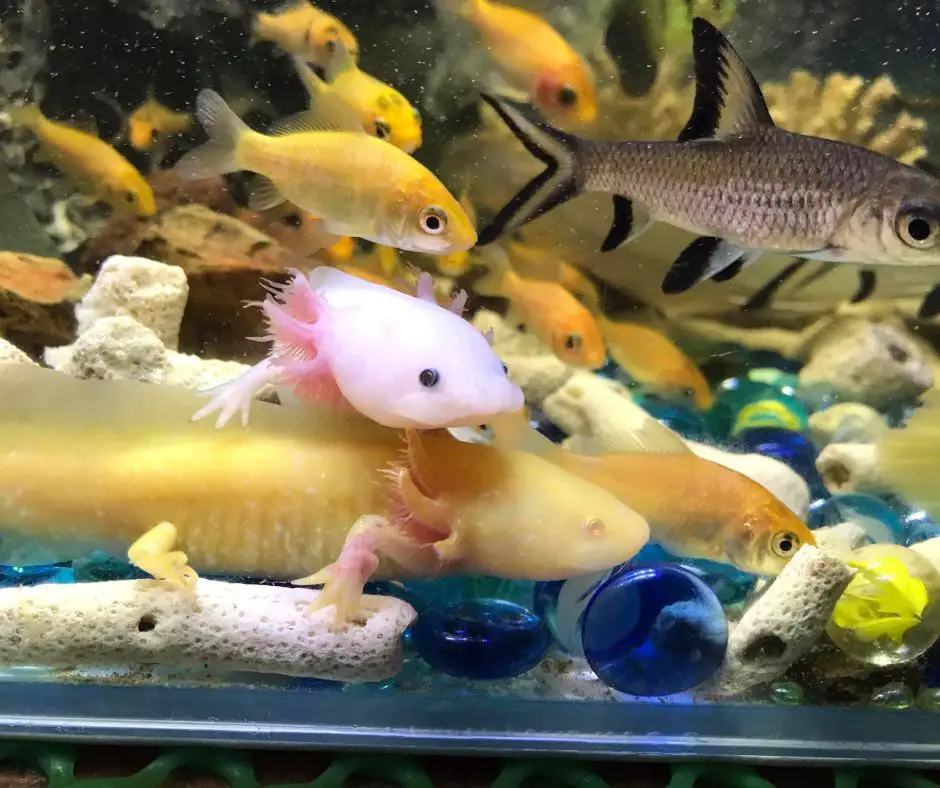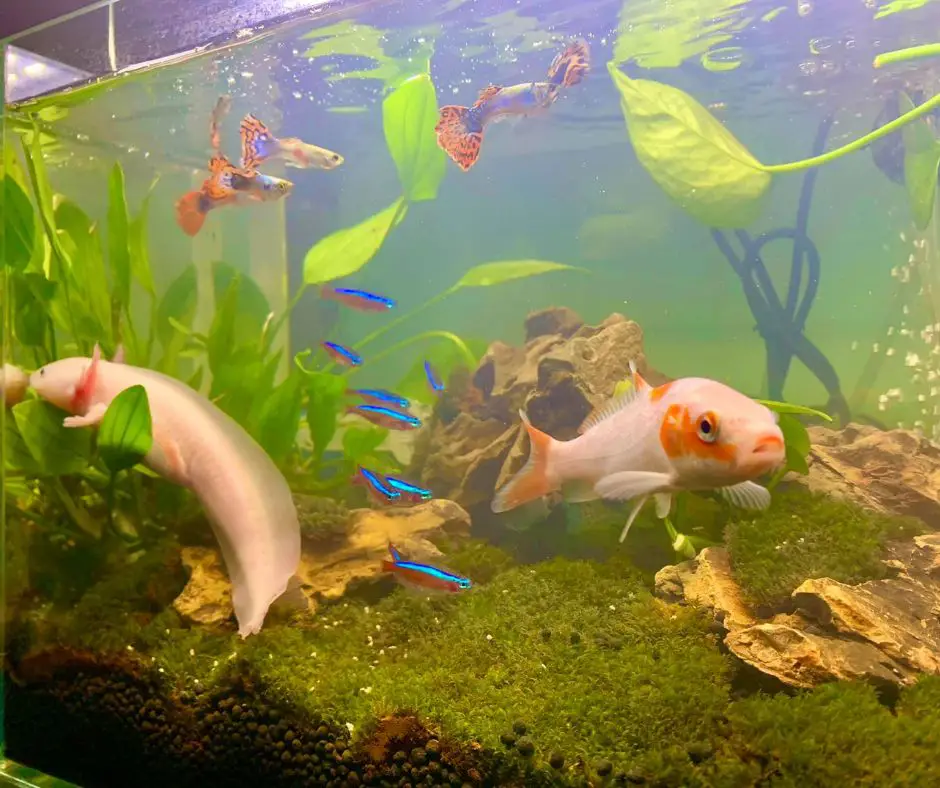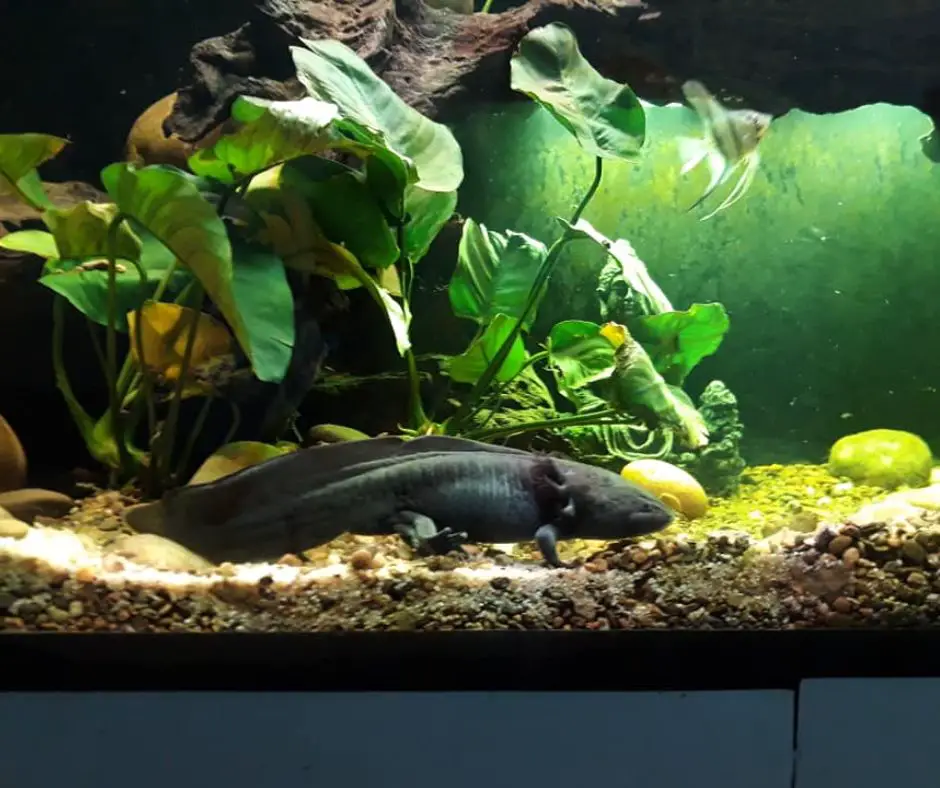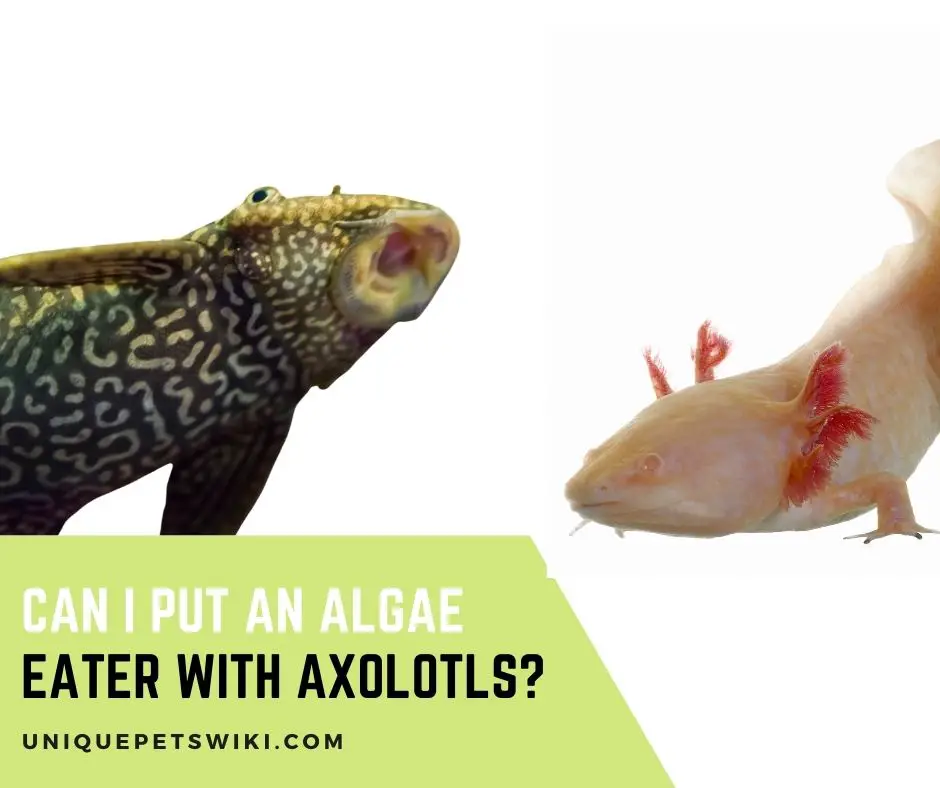An algae eater could be a fish or an invertebrate like a snail or shrimp. They are called algae eaters because they eat algae.
Some algae eaters eat only one form of algae, while others feed on a variety of different algae.
Considering their size, can you put an algae eater with axolotls? Yes, you can but it is not advisable.
Here are the reasons – algae eaters feed on different types of algae and putting them in your axolotl’s tank would mean providing or giving room for some algae so they (algae eaters) can feed.
In particular, some algae eaters are likely going to nip at their gills. So what should you do? Read on to learn what type of algae eaters you can add to your axolotl’s tank.
Contents
Can I Put an Algae Eater With Axolotls?
Yes, you can put an algae eater with axolotls as long as safety guidelines are followed and they’re getting along.
Algae eaters you can add to your axolotl’s tank are minnows, guppies, large apple snails, and snails.
However, it isn’t recommended. The main problem you’re likely to face is that most algae eaters could nip at your axolotl’s gills or damage their slime coat.
In other hand, axolotls don’t really care if they live with tank mates or not.

Is Algae Bad for Axolotl?
Algae is not harmful at all but their activities in the tank can cause harm to your axolotls.
Algae are plants that produce lots of oxygen more than they consume during the day but at night and on cloudy days, they remove oxygen from the water.
For instance, the blue-green algae consume the oxygen in the water and produce harmful chemicals that can cause health problems to your axolotl.
If this continues for a longer time, your axolotl could die as a result of a lack of oxygen.
Also, algae extract or absorb nutrients from the water.
Knowing the dangers of having algae, especially the blue-green algae in your axolotl’s tank for a longer time, to keep your axolotl safe you need to remove the algae manually as soon as you notice it.
Ensure the tank is completely clean before refilling it with fresh water and reintroducing the axolotl.
Although algae can be beneficial to your water quality by absorbing nitrates out of the water, you should be careful if you have them in your axolotl’s tank.
Instead, you can have live plants as these ones are less harmful to your axolotl.
Best and Worst Algae Eaters for Axolotl

A few of the best algae eaters you can add to your axolotl’s tank include white cloud mountain minnows, guppies, zebra danios, (adult) apple snails, and shrimp.
These animals are considered ideal for axolotls’ tank because they are small, peaceful, and tend to live in the same habitation as axolotls – that is a cool water environment.
They are slow-moving animals just like axolotls and swim really slow. They are not aggressive in nature, so you’ll have minimal cases of gill nibbling.
They possess no small exoskeletons or boney spines therefore, they pose no choking/impaction risk to your axolotls.
On the contrary, the worst algae eaters you should never add to your axolotl’s tank are goldfish, small snails, cory catfish, and otocinclus catfish.
These animals, especially small snails pose a choking hazard to the axolotl since it has a hard exoskeleton.
Besides, most of these animals such as cory catfish and otocinclus catfish have sharp spines on their dorsal and pectoral fins. With these they can injure your axolotl should your axie tries to eat them.
Algae Eaters Alternatives
A safer way you can keep algae out of your axolotl’s tank without having to put algae eaters is to do the following:
- Manually clean the tank and make sure you scrape off algae from the tank and tank accessories right before you add freshwater to it.
- Use a Liquid Carbon Solution such as Flourish Excel to kill algae in your pet’s tank.
Also read: How to Keep An Axolotl Tank Clean
How to Prevent Algae Growth

If you can get rid of algae in your axie’s tank, that will be amazing. But as we know this is going to be tedious work and it’s almost impossible.
Therefore, instead of thinking about how to get rid of it, you can prevent it by having some aquatic plants in the tank and reducing the amount of lighting and food supplied.
Reduction In Lighting
Algae need light to thrive. The more lighting you have in the tank, the quicker the algae will grow. Evaluate your tank’s lighting and minimize it as much as possible.
Normally, you are to maintain a 10 – 12 hour per day lighting in your axolotl’s tank, but when you’re dealing with algae prevention, you may consider reducing the length of daytime light you provide.
Food Reduction
Apart from lighting, algae also grow when there is an excess amount of nutrients in the water.
You can reduce the amount of nutrients in the water by feeding your axie less food and frequently changing the water.
Note that overfeeding and infrequent water changes can cause health issues for your pet. So, minimize the leftover foods you have in the tank after each feeding and do a regular water change.
Ideally, change about 25% of the water once every week and full water change every month.
VIVOSUN Aquarium Gravel Cleaner
- Premium Material: Made of safe, non-toxic plastic that is both solid and BPA-free, this aquarium cleaner will not do harm to your pets; This hose differs from vinyl tubing and prevents kicks and roll-ups, ensuring that water flows smoothly
- Durable Operation Bulb: Equipped with a large operation bulb which is sturdy and durable so you can get the water flowing without further pumping; Just pump 5- 10 times and it’ll start up
- Flow Control: Excellent design with a clamp; Comes in handy to control the amount and speed of water and prevents messes from occurring
- Dual Nozzle Design: Made with two nozzles; The shorter nozzle is used for draining water from the tank; The longer nozzle is used for washing and cleaning gravel, sand, and substrate
- Small Suction Cup: Comes with a small suction cup that attaches the nozzle to the glass wall of your aquarium for a complete one-hand cleaning operation; You don’t need to monitor while moving water out of the tank
Last update on 2022-12-29 / Affiliate links / Images from Amazon Product Advertising API
Aquatic Plants
A more natural and safer way to deprive algae of the nutrients it needs, causing it to die off is by having live aquatic plants in the tank.
The aquatic plants will use up the nutrients the algae needs to survive, resulting in fewer algae.
Besides, aquatic plants also keep your water parameters steady such as providing shade and reducing excess light.
Check out: 6 Best Cold Water Plants for Axolotl
Frequently Water Changes
As stated earlier, one way to encourage the growth of algae is to “NOT change your water frequently.”
So when you change the water frequently it lessens the nutrients in the water and reduces the growth of algae. Fresh, clean water limits the growth of bacteria and algae.
Ensure Your Filter Is Working
The filter in your pet’s tank not only cleans the water but also reduces the amount of algae food in the tank. Thus, less food = fewer algae and no food = no algae.
Check out: 7 Best Water Filter For Axolotl
hygger Carbon Fiber 6 in 1 Aquarium Cleaning Tool Kit Algae Scraper
- hygger 6-in-1 cleaning tool kit helps to keep tank neat and clean without getting hands wet. Made to last long time and makes cleaning the tank a breeze
- Aquarium cleaning tool kit includes a telescoping handle, 1 gravel rake, 1 metal blade, 1 flat sponge cleaner, 1 right-angle sponge, 1 tube brush and 1 fish net. For replacement sponges, ASIN B081SRY68V
- Stainless steel scraper attachment for cleaning tough stuff, tube brush for cleaning pipe, gravel rake for raking and cleaning gravel, flat sponge for substrate and glass cleaning, right-angle sponge fits into hard-to-reach corners for complete cleaning
- Telescopic handle: Premium carbon fiber composite construction, it can be extends from 19.7 inch to 35.4 inch which is long enough to clean up to 2.65 ft depth tank. Threads together with extension tightly no flexing, it can keeps water from go into pole
- Designed with spring closure, attachments will sit tightly on rod firmly and securely. Ideal for cleaning home aquarium.
Last update on 2022-12-29 / Affiliate links / Images from Amazon Product Advertising API
Wrapping Up
It’s no easy task for someone with a busy schedule to maintain an algae-free aquarium. It’s something that is likely to happen if you don’t frequently change the water in your axie’s tank.
But introducing algae eaters to keep algae low isn’t entirely a good idea as your axolotl is at risk of either being eaten or injured.
What then should you do? Prevent it. Prevent the growth of algae by making the tank ideal for your axolotl to live but unfavorable for the algae to thrive.


